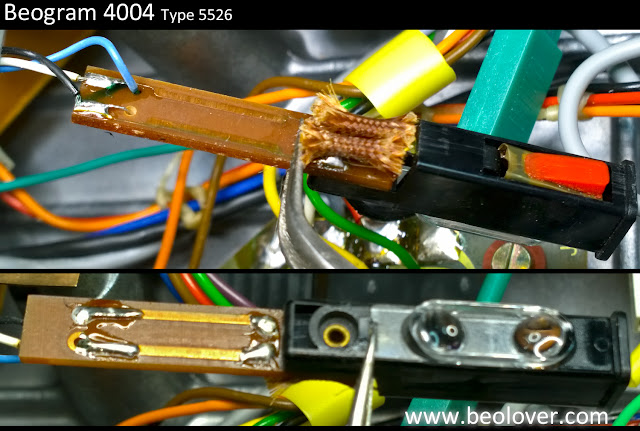This Beogram turntable has a new LED lamp source for the record detector circuit that is in the fixed arm. Part of that installation involved switching out a fixed 1MOhm resistor (1R26) with a 2MOhm trimmer resistor to allow better tuning of that detector circuit voltage. With the turntable parts re-installed I started the procedure of making an initial setting of the new 1R26 trimmer so the collector of 1TR3 is at 4 VDC when the fixed arm lamp is on.
I made that adjustment then moved the 1R26 trimmer resistor to the component side of the board where it belongs (so it is out of the way of the platter).
A quick test of the Beogram Start, without a record on the platter, passed with the sensor circuit correctly recognizing there was no record on the platter.
To complete this test however it is always a good idea to actually see the signal on an oscilloscope. I connected a probe wire to the 1TR3 collector and then to my scope. When I ran the fixed arm and tonearm over the platter I paused it so I could measure what the detector circuit is seeing.
I was surprised and disappointed to see that the peak to peak voltage of the signal was not from 0 V to around 6 V as expected. It only drops to about 2 V and goes up to 4.72 V.
So while the Beogram appears to detect an empty platter as it should, the signal is not ideal and could lead to problems later on. A little bit less peak to peak voltage and this circuit will not detect an empty platter.
I wanted to know if the problem was in the new Beolover light source assembly or with the fixed arm light sensor. The easy thing to try first was to use a powerful LED flashlight to enhance the light on the platter. When I did that I could make the 1TR3 collector signal go to its full range. But look how much light it took for the sensor to register that. Something must be wrong with the sensor.
As a second part of the test I pulled out the fixed arm lamp and sensor assembly a ways so I could move the Beolover LED module and watch the effect on the 1TR3 collector voltage.
Moving the LED light source could not make the signal peak to peak range any better. It could make it worse though and confirmed my fear that a little less voltage would cause the platter detection to fail.
Next step then is to swap out the fixed arm sensor. I decided to swap out the entire assembly first with one of my spares (from another Beogram 4004 turntable).
Here is the removal of the current sensor assembly that has the Beolover LED light source.
Here is the replacement sensor assembly. It still has an original incandescent light source.
Just like that, the 1TR3 collector signal went right to what is expected. The peak to peak voltage is from 0 V to about 6 V.
That voltage is with a dimmer light source as the Beolover LED light source is brighter than the incandescent lamp. The original fixed arm platter sensor is the problem and will have to be replaced.
Featured Post
Beolover SyncDrive: DC Platter Motor Replacement for Beogram 4002 and 4004 (Type 551x and 552x)
Late Beogram 4002 and the 4004 (Types 551x and 552x), which have DC platter motors instead of the earlier synchronous AC motors usually suff...
Subscribe to:
Post Comments (Atom)












Excellent article,it makes me understand a little bit more about my B&O Beogram 4004 turntable, thank you and im looking forward for more articles.
ReplyDeleteRgds
Antonio
Thank you for the comments Antonio. I'm glad the information is useful to you. I learn something myself each time I work on one of these wonderful machines.
ReplyDeleteRegards,
Sonavor
I'm the 4004 owner-I don't know how to comment except as anonymous-and I could not be more pleased my late father's 4004 is in Sonavor's hands.I am not sure whether I enjoy the documentary or the machine better!
ReplyDelete